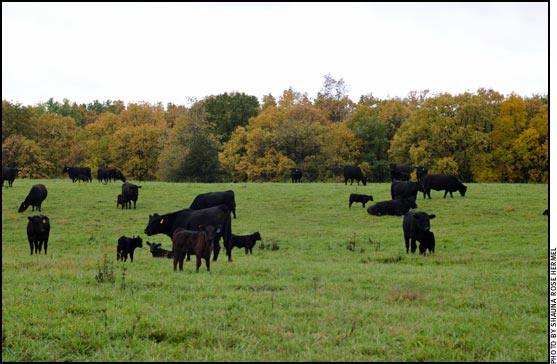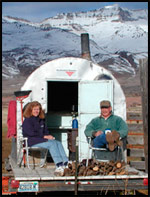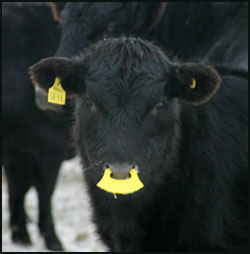MANAGEMENT...

Sharing System for Quality Premiums
Quality Beef program can return more dollars, producers learn at
MU Wurdack Farm field day.
Quality beef brings rewards far above the market average, cow herd owners learned at the University of Missouri (MU) Wurdack Farm field day in Crawford County, northeast of Salem, Mo., Oct. 5.
"The current Prime quality-grade premium is $28 per hundredweight," said Mike Kasten, speaking on "Quality Beef by the Numbers." On an 800-pound (lb.) carcass, that adds $224 above market price paid by packing plants.
"That means dollars in your pocket, and they are available now," Kasten added.
Read more.

Ron Torell with his wife, Jackie
Cow Camp Chatter
Forage-based heifer development programs
require slow but steady gain.
Many higher-precipitation regions of the United States produce an abundance of quality forage year-round, requiring little if any supplemental feed to properly develop heifers for breeding. For the rangelands of the arid and semi-arid American West, it's a different story. By fall, these rangelands produce 450- to 500-pound (lb.) weaned spring-born heifer calves. Ranchers often will retain 15%-20% of the heifers as replacements.
In an effort to obtain a 700 lb.-plus target breeding weight by spring, winter development rations generally consist of quality homegrown native hay along with a few pounds per head per day of a grain-based supplement for added energy and protein. This winter ration generally yields an average daily gain (ADG) of 1.25 lb.-1.75 lb., which is more than sufficient to reach the spring target breeding weight.
Due to the severity of the 2012 drought and the effect it has had on the price of grain and grain byproducts, the grain-based method for reaching target breeding weight may now have to be re-evaluated.
Read more.
Rough Summer, Mild Winter?
Changing Pacific temperatures will give Midwest a break.
After this summer's record drought, will there be a brutal winter in the Midwest? A climatologist with the University of Missouri (MU) is predicting a slightly warmer-than-normal winter and a little below-average precipitation.
"This is consistent with a weak El Niño pattern in the central Pacific," said Tony Lupo, chair of the Department of Soil, Environmental and Atmospheric Science in the School of Natural Resources. "The current El Niño is quite weak and may not even rate as one when all is said and done."
Lupo said the climate data for September 2012 shows a trend from a fading La Niña to a fragile El Niño pattern in the Pacific basin. The Equatorial sea surface temperatures there have a strong influence on weather patterns over North America. A persistent La Niña over the last two years was a major reason for the lack of rain over much of the United States. Read more.
Cooperator Option Offers Revenue Potential
Producers looking to increase calf crop value could turn to surrogacy.
Looking for a new way to add value to your calf crop? Try raising someone else's calves instead of your own, an Ohio State University (OSU) Extension beef expert said.
Producers interested in maximizing income from their calf crop while controlling input costs can consider using their commercial cows as surrogate mothers to raise calves for other producers, said John Grimes, beef coordinator for OSU Extension.
Read more.
Weaning Calves with Nose Flaps
Wyoming producer says process was less stressful
on the calves and him.
 There are many ways to wean calves. The ultimate goal is to wean with the least stress — to keep calves healthy and keep them gaining.
There are many ways to wean calves. The ultimate goal is to wean with the least stress — to keep calves healthy and keep them gaining.
Andy Gray, who grazes 500 cows near Douglas, Wyo., last year tried a new weaning method, using nose flaps on the calves. These plastic flaps can be easily installed with the calves restrained in a chute. Afterward, the calves are returned to their mothers. The flap hangs down over their nose and mouth, preventing the calf from grabbing a teat to nurse. The nose flaps don't hinder eating grass or hay or drinking water. Read more.

Kris Ringwall
Beef Talk
Understanding culling and replacement rates is critical.
Culling and replacement rates are the two numbers that will affect the base cow herd. These numbers are shifted as managers determine how to fit cattle to given resources. The rates are the foundation to expanding and contracting cattle numbers.
Knowing one's culling and replacement rates and relating those numbers to industry numbers is important. The North Dakota Beef Cattle Improvement Association (NDBCIA) keeps track of many traits for producers through the Cow Herd Appraisal Performance Software (CHAPS) program. Since 1990, the typical culling rate has been 14.1%, while the typical replacement rate has been 17.8%. Read more.
New Products
Industry affiliates provide a wide array of products and services to assist you on the farm and ranch. Here's an assortment of new products to hit the market recently.
- Respiratory protection in one dose
- Updated pest control reference
- Cost-saving automatic bale wrapping
- Double-knife sickle cutterbars
- Agritourism safety guide
- Replacement windrowers
Angus Advisor
Click here for October herd management tips from cattle experts across the nation. Advice separated by region.
[Click here to go to the top of the page.]











